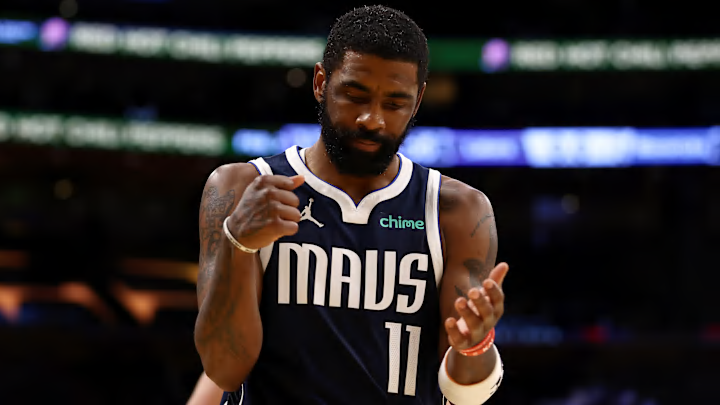We are approaching the one-year anniversary of the trade that sent All-NBA combo guard Kyrie Irving to the Dallas Mavericks. Now that we have had time to see how the deal has played out for both sides, it is time to reassess and re-grade the move.
The Dallas Mavericks have acquired eight-time All-Star Kyrie Irving along with Markieff Morris from the Brooklyn Nets in exchange for Spencer Dinwiddie, Dorian Finney-Smith, a 2029 first-round pick and two future second-round picks. pic.twitter.com/bmBZFXGJV4
— Mavs PR (@MavsPR) February 6, 2023
What did the Dallas Mavericks trade for Kyrie Irving?
On Feb. 6, 2023, the Mavericks sent Spencer Dinwiddie, Dorian Finney-Smith, a 2029 first-round pick and two future second-round picks to the Brooklyn Nets in exchange for Irving.
Irving signed with Brooklyn in 2019 to play alongside two-time Finals MVP and longtime friend Kevin Durant but requested a trade last season after he and the Nets were unable to come to terms on a long-term contract extension.
The move was widely regarded as a risky proposition for the Mavs at the time due to Irving’s outspoken yet unpredictable personality, on-court availability (he has played at least 60 games once since 2019-20), and pending free agency.
At first, critics looked like they were right. Dallas brought in Irving only to finish with a 38-44 record and miss the playoffs entirely. However, they gave themselves the inside track to signing Irving to a lucrative contract this offseason, which has paid dividends.
The Mavericks and Irving agreed to a three-year, $120 million deal with a player option in the final season, meaning he is under team control for at least one more season beyond 2023-24.
After missing the playoffs last season, Irving, Luka Doncic, and the Mavs have come with a vengeance. Sitting at 24-18, Dallas is currently in sixth place in the Western Conference standings, and the duo of Irving and Doncic has been one of the most dangerous backcourt tandems in the NBA.
How have the Brooklyn Nets fared sans Kyrie Irving?
Irving’s trade request had a monumental impact on the outlook of Brooklyn’s future. A few days after they sent him to Dallas, the Nets traded Durant to the Phoenix Suns in a blockbuster deal that netted them Mikal Bridges, Cam Johnson, four first-round picks, and a pick swap in 2028.
In a matter of roughly 72 hours, the Nets parted ways with two of the most talented players in NBA history who were still in their prime and showing no signs of slowing down.
While that may sting for the Nets and their fans given the failed experiment that was Irving, Durant, and former NBA MVP James Harden in Brooklyn, they are now in a better position for sustained long-term success.
Their decision to move on from Irving and move on from their attempt to construct a superteam ultimately motivated them to send Durant to Phoenix, landing the Nets a franchise cornerstone in Mikal Bridges as well as a sharpshooter in the form of Cam Johnson. Not to mention, they received five first-round picks (plus a pick swap), and two second-round picks.
Moreover, the Nets are also shopping Finney-Smith with an asking price of two first-round picks, which would further add to their war chest of draft capital as a result of the Irving trade.
Nearly one year later, the fallout of the deal that sent Irving from Brooklyn to Dallas has aged nicely for both sides. Despite sacrificing a championship window, the Nets expedited what would've been a lengthy rebuilding process. Conversely, the Mavs improved their chances of competing for a title drastically by acquiring a second star to pair with Doncic.
